F
FishingMagic
Guest
Dave Coster – Fishing at Long Range
HITTING THE HORIZON
Match and pleasure anglers have discovered casting further can bring rich rewards, embracing long-range feeder tactics, and taking them to a new level. John Bailey says he too has had to follow the trend of casting into the beyond, due to predators and angling pressure. From a match fishing point of view, out-distancing those around you makes good sense, chasing after fish all the disturbance pushes away. Over in Ireland, yet another factor has forced anglers into longer casting, and that’s zebra mussels, which have filtered the colour out of many big Irish loughs. UK anglers who go to the Emerald Isle have learnt to add more metres to their fishing. Many have enjoyed this challenge, bringing the trend back to our shores. I managed to take this snap of my pal Chris, as his feeder rod followed through after being fully compressed for a huge chuck. Feeder fishing now embraces powerful quivertip rods and big pit-style reels, capable of casting massive distances.
KNOWING THE SCORE
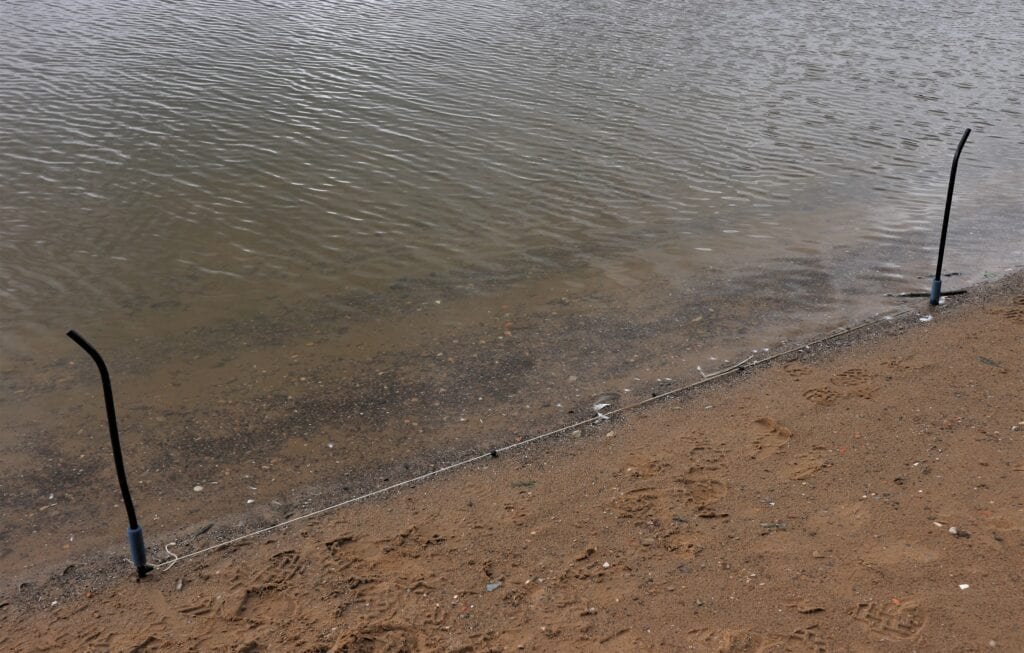
If you are going to all the trouble of fishing an immense way out, it helps to know exactly where your end tackle is landing. Everyone uses a far-off feature to aim at, but the way we gauge feeder fishing distances is changing. Most anglers used to do this by counting the turns of line onto their reel, while winding back in from the target spot. But this is tedious, and easy to get wrong over big expanses. Far better to use measuring sticks (as JB has also mentioned), which give you the proper range in metres or yards, depending on how you space them. Many measuring sticks have a couple of marker toggles, allowing you to gauge two different feed lines. It’s popular practice these days to have a short-range feed area to kick off sessions, while waiting for the distant line to come to life. Using sticks is also far more accurate if you want to match up with your main rod’s casting distance by using a spodding rod, or having spare back-up tackle, such as different feeder set-ups.
FEEDER EVOLUTION
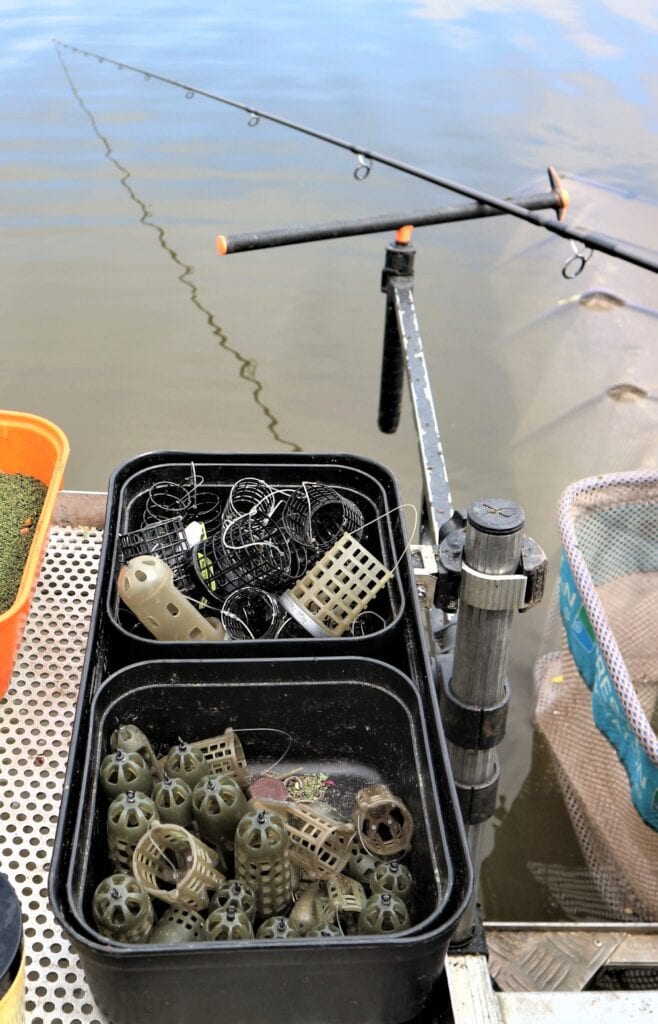
The type of long-range feeders anglers are using these days has in many cases changed. A few side lead groundbait designs can still be seen around, but these models have limited casting potential. Rocket-style cages with big base weights are not recent innovations, but I see these being used much more on big lakes, gravel pits and reservoirs. This style of groundbait feeder first originated in Holland, I believe. I remember seeing Dutch anglers using them on big, windswept Irish festival venues, way back in the early nineties. But the new boys on the block for long range are window feeders. These were first widely used in Ireland, thanks to the crystal-clear water problems previously mentioned, which have pushed the vast bream and roach shoals a long way out. Tough plastic cage feeders with weighty lead rings around their bases are also popular for long range, again originating from Dutch feeder anglers, who have always liked big chucks for their bream.
FEEDING REVOLUTION
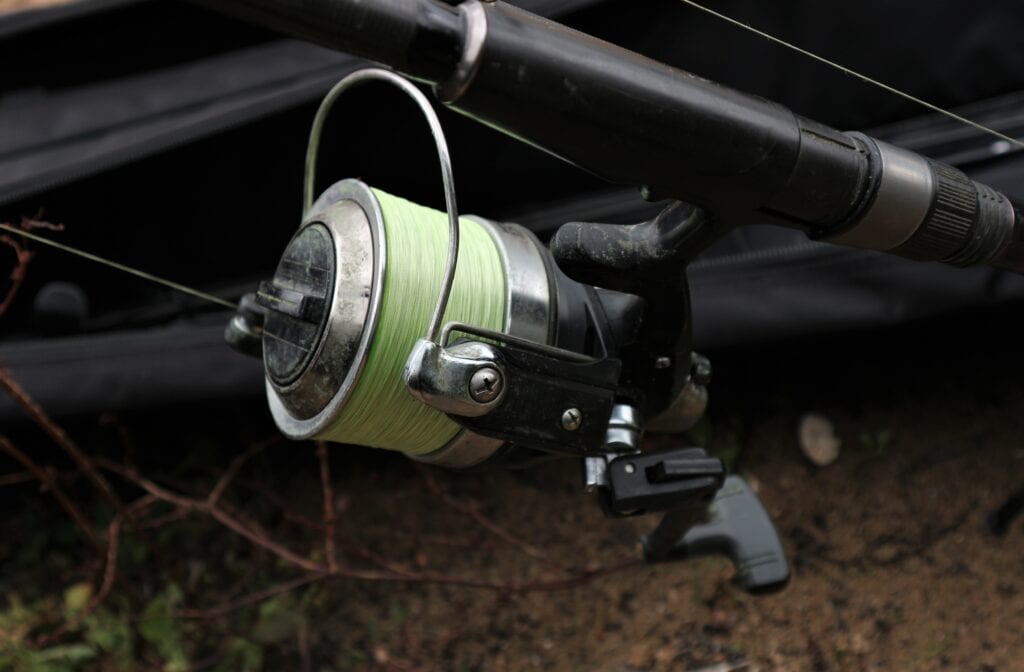
The use of groundbait catapults has declined considerably. Much of this is undoubtedly to do with the extra metres anglers are adding to their casts, going well beyond the range catapults can comfortably manage. But there is more to this, because extreme-range feeder anglers are striving to be more precise, clipping up, and attempting to put their end tackle down the same hole every chuck. To begin with, this new precision way of fishing involved extra-big spodding-style cage feeders, to help build swims a lot faster. But proper spodding, similar to what carp and specimen anglers have been doing for years, has crept into the serious feeder angler’s armoury much more. This entails beefy, beachcaster-style rods and big pit fixed-spool reels with large-diameter alloy spools, loaded to the brim with thick braid. All this might sound a bit over the top, but the new type of Spombs deposit a lot more bait, just as accurately as a feeder and far more quickly.
TIMING IS KEY
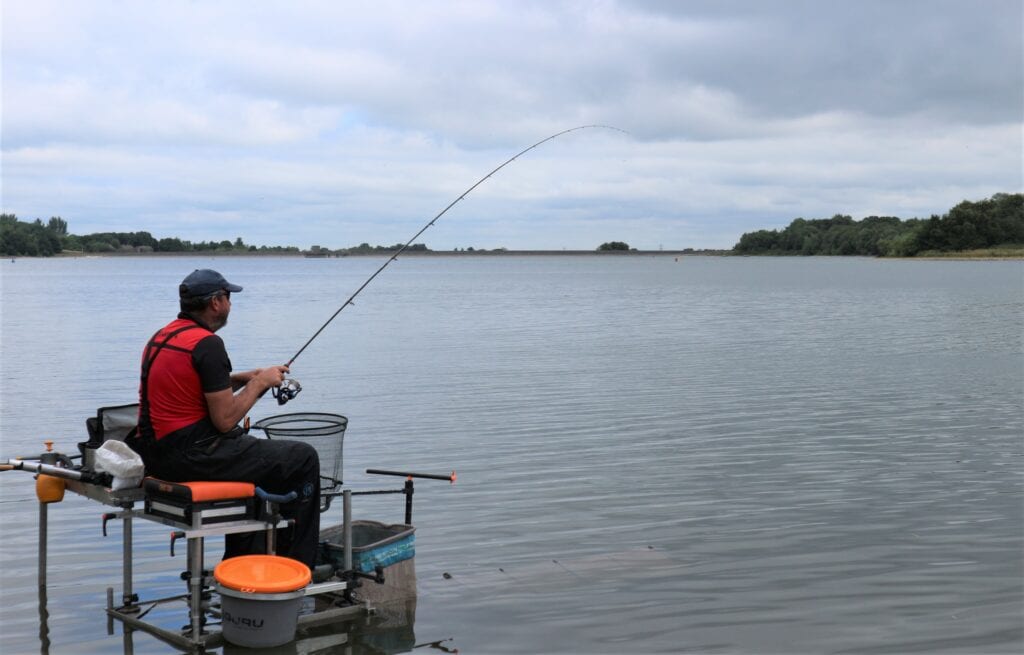
If you are not careful, it’s easy to go to sleep while feeder fishing. Not literally, but becoming transfixed by watching what a quivertip is doing, or not doing. This can lead to forgetting about topping up with more feed, which is essential to build swims up. That’s why many long-range feeder anglers these days use timers. I’ve watched top feeder guys and they regularly make themselves wind in and cast more bait out for the first hour of a session, giving each cast a set amount of time. Once the bites start coming this can change, adding or subtracting a few minutes every chuck, depending on how the fish are responding. The clever bit with using a stopwatch, is you get to know exactly how long to give each cast before expecting a take. If one doesn’t come, your hook bait might be damaged, or could have come off, or maybe it has become buried in debris. Retrieving and casting again often brings an instant response. Active fishing catches a lot more fish!
CHANGING BAIT MENUS
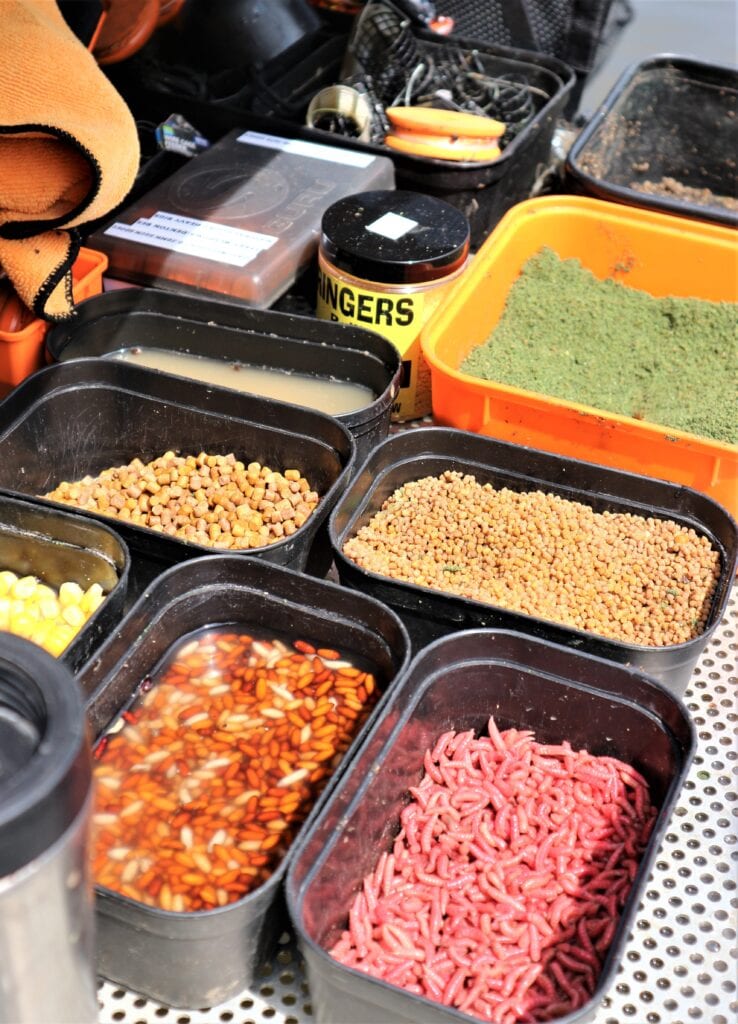
Most long-range fishing, excluding carp, is aimed at bream and tench. It’s targeting these species that has forced JB’s hand into at least hitting the 70-80m zone. Big bream, in particular, can inhabit areas a long way from your bank quite naturally, but the way carp anglers fish and feed at range, almost by second nature these days, might be responsible for many big fish staying so far out. Also, due to the type of baits carp anglers use, it’s advisable to carry a good selection of grub when targeting feeder fish on big expanses of water. Green-coloured groundbaits with fishmeal are currently very popular. These are loaded with plenty of chopped worm, casters, and various sizes and types of pellets. Small expanders are something skimmers in particular like, switching to hair-rigged sweetcorn or banded wafters for bigger fish. It’s a case of working through a menu to see what works. Sometimes natural baits pay off, while on other occasions it’s pellets and wafters.
A NEW SCIENCE
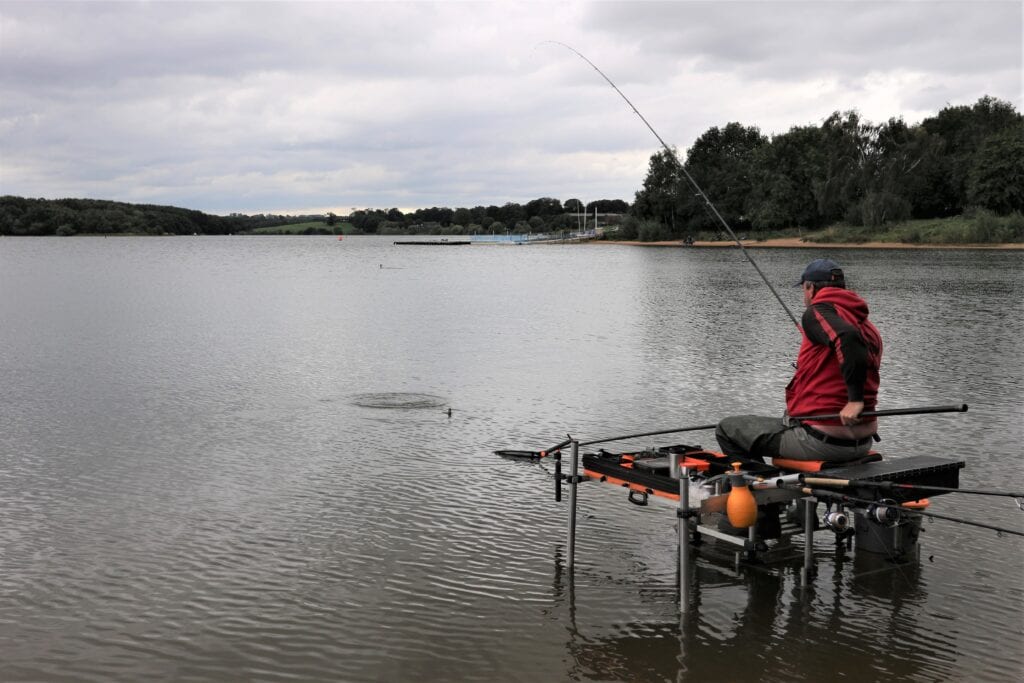
I make no apologies for relying on my mate Chris to show how distance fishing is evolving, because he has put much more effort than I have into this new way of doing things. His sturdy fishing station is superbly geared up for stealing vital extra yards when set up well out in the water. Everything’s brilliantly tailored for housing plenty of bait, spare rods and whatever the weather can throw at it. My humble seat box, footplate and basic 40-year-old platform look a bit sad in comparison! But hey, if I concentrated on the big stillwater match circuit like my friend does, I would undoubtedly go the same way. For me this is more an occasional trip, as I have been preoccupied with a mixture of canals, drains, rivers, and mainly smaller venues since moving to the Midlands. Anyway, after priming the big-chuck part of his swim, then catching a few decent roach on a closer feed line, Chris has discovered bream and skimmers have arrived at distance. It only took them an hour.
THE HYBRID WAY
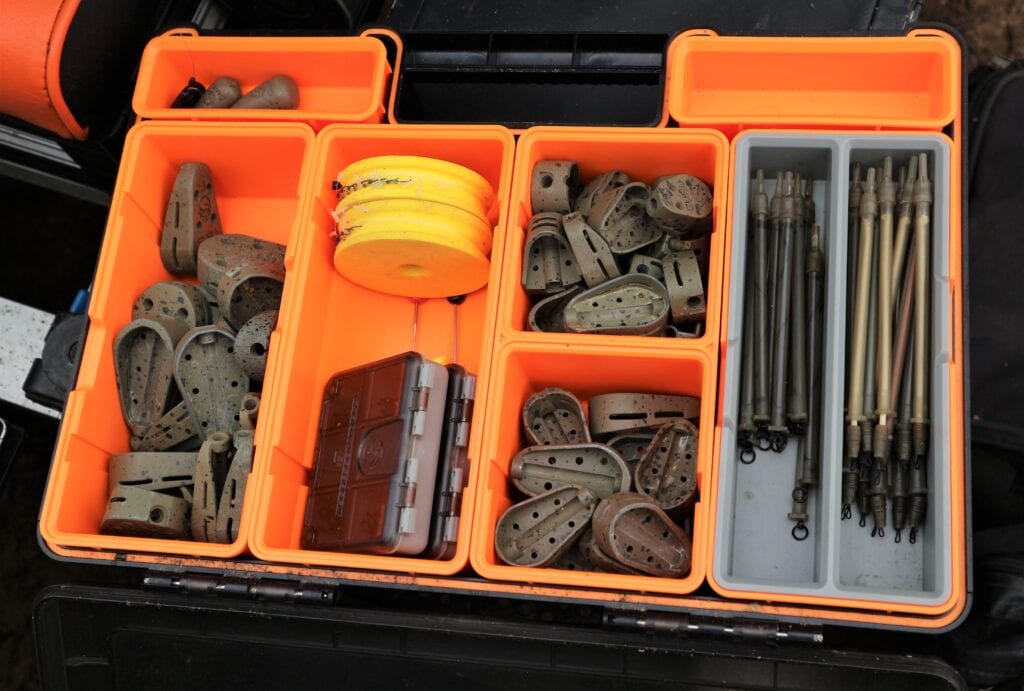
Another new type of feeder has revolutionised fishing at extreme range, casting more like a bomb or leger weight, and that’s the flat hybrid design. This is close to a method feeder minus the vanes, similar to a flattened leger weight, but with a shallow fence around it. The advantage match anglers like with hybrids is you don’t need to use a mould with them, so they are quick to load up with pellets or groundbait. Also, being super-streamlined, 40g and 60g versions cast incredible distances for their size. Favourite loadings are micro pellets or groundbait, the latter in fishmeal form during the warmer months, switching to sweet recipes in winter. This is basic stuff, using short links and buried hook baits, much like the method. Big bream respond to this tactic, which is particularly effective at range in shallow, weedy venues. Find where the fish are, and very often no extra grub is needed, just a few casts introducing some pellets or groundbait. Top hook baits are bunches of maggots, banded wafters, or hair-rigged corn. Altogether, a recipe for a great day’s sport.
FISH FINDING
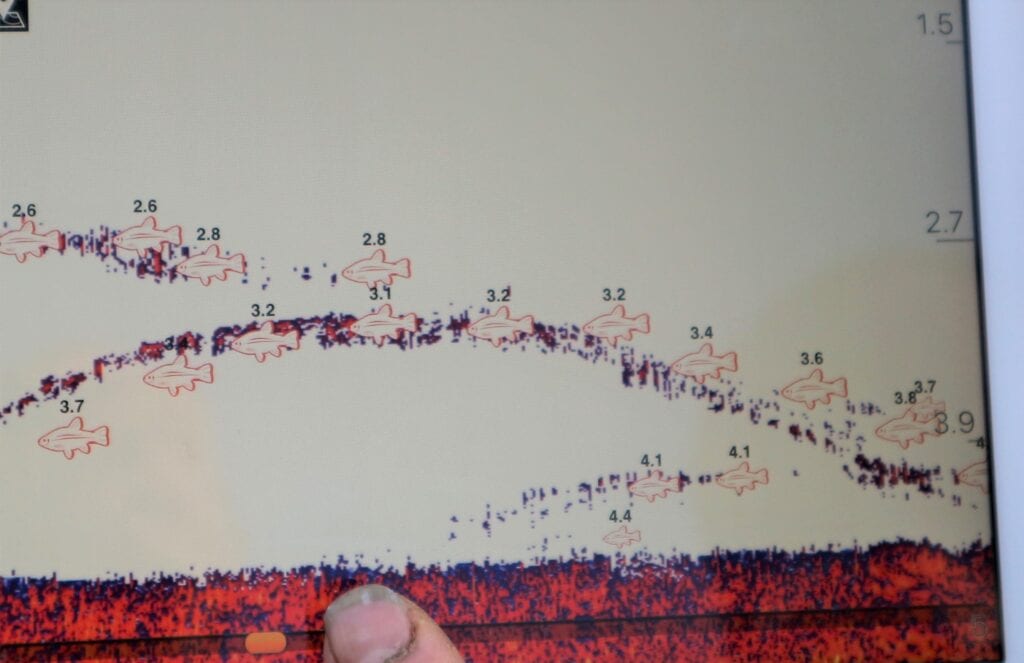
Deeper sonar devices are helping anglers locate fish. This high-tech buoyant ball can be cast out on a spare rod (using strong line so as not to lose it!) and on the retrieve it shows up everything under water, on an iPhone or tablet. This gizmo highlights depth and bottom terrain, along with any fish, of course. The latter information helps when you are not catching, at least telling you something is out there. I have witnessed one of these fish finders being used by a mate on a rock-hard reservoir. We were both fishing a fair way out and couldn’t get a bite between us. He cast the ball into both our swims and, as you can see from the accompanying photograph, big fish were showing up everywhere, mainly hovering well off bottom. We tried everything but couldn’t make them feed. The interesting part was the tablet was showing fish where we were casting to, so at least our range finding was good. Personally, I like the mystery factor, so this is not really my cup of tea.
WHERE THEY LIVE
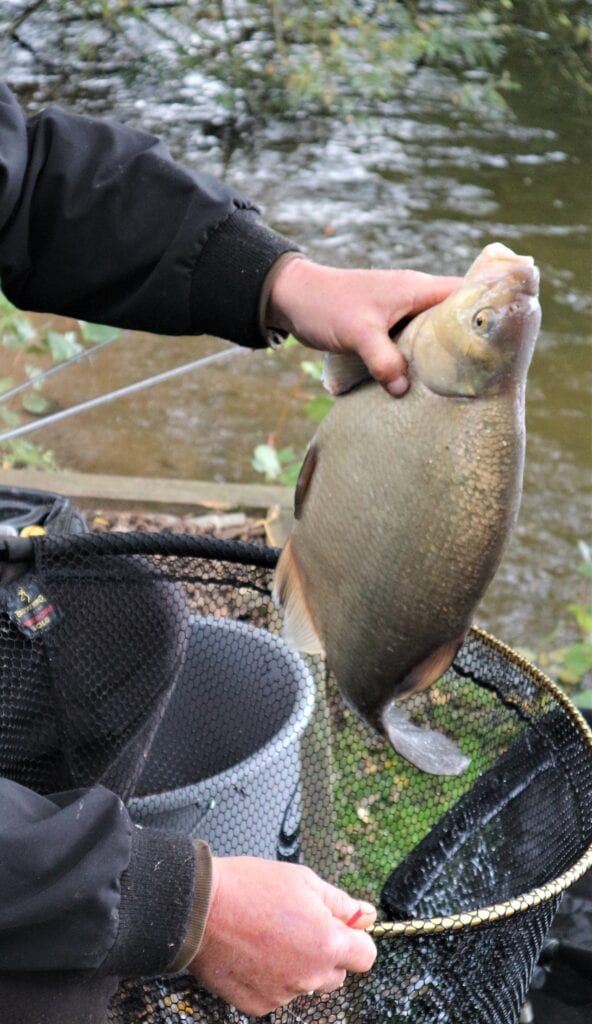
As JB has observed, sometimes the target fish, especially bream, don’t live where you like to fish. We all have our favourite methods and swims, but I for one will change what I’m doing if it makes a big difference. As JB says, there are just as many features at long range as there are closer in, so don’t ignore those far-off gullies, gravel bars, plateaux and distant islands. Simply blasting a feeder as far as you can into open water, and hoping the fish come to you, can work, but I know plenty of venues where swim knowledge is required. The bigger bream on some of the large lakes I fish just don’t budge very much, apart from the May/June period when they tend to shoal up and move off for spawning. Otherwise, there are only a handful of areas where they can be caught in large numbers. Having a powerful feeder rod comes in handy here, because the short-chuck swims are often taken. Being able to cast into the vicinity from the other side of the lake has its advantages!
THE AGE THING
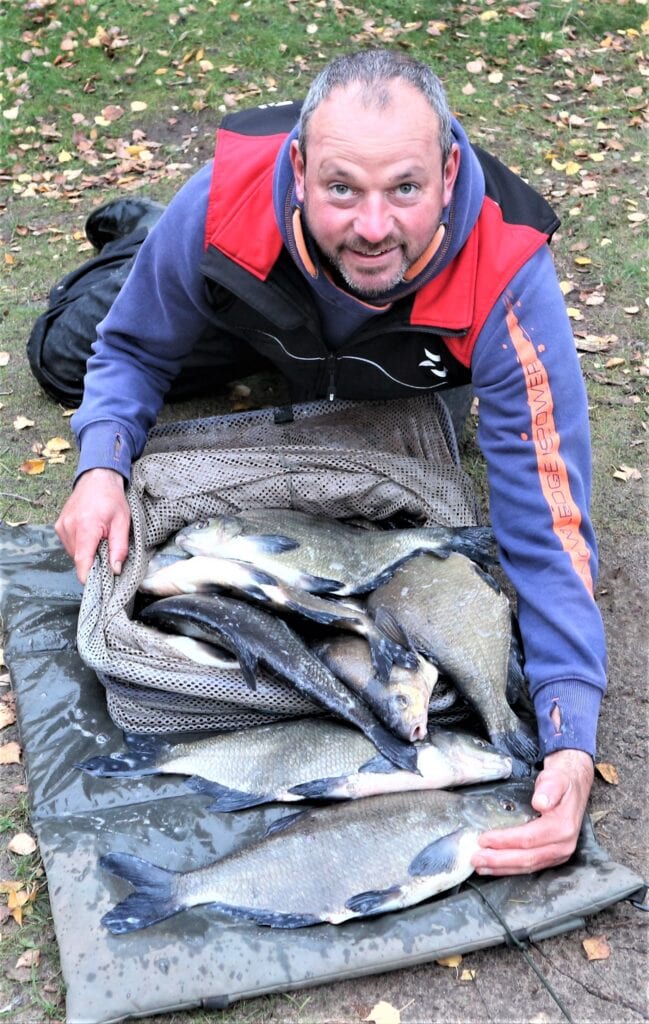
As JB mentioned, there are some “old rockers” who can sling tackle as far as anyone, but age does have an effect on distance fishing, at least for most of us. I have watched carp anglers swishing out baits amazing distances, handling rods like Samurai warriors wielding their treasured swords. My mate Chris is super-fit due to his running, and whizzes out feeders so far, I can almost drink half a cup of coffee waiting for them to splash down. Some of us need to be careful here, because this distance stuff can cause sports-related injuries, like the time I got tennis elbow. Not funny because it took months to shrug off. But then again, a lot of good distance casting is down to perfect timing and compressing the blank properly. Some anglers stand up to launch out, while others who have mastered timing and physics, simply sit casually on their seat boxes and still hit the horizon. The catch Chris took here was not taken at extreme range, but at what I call dominant range.
LENGTH FACTOR
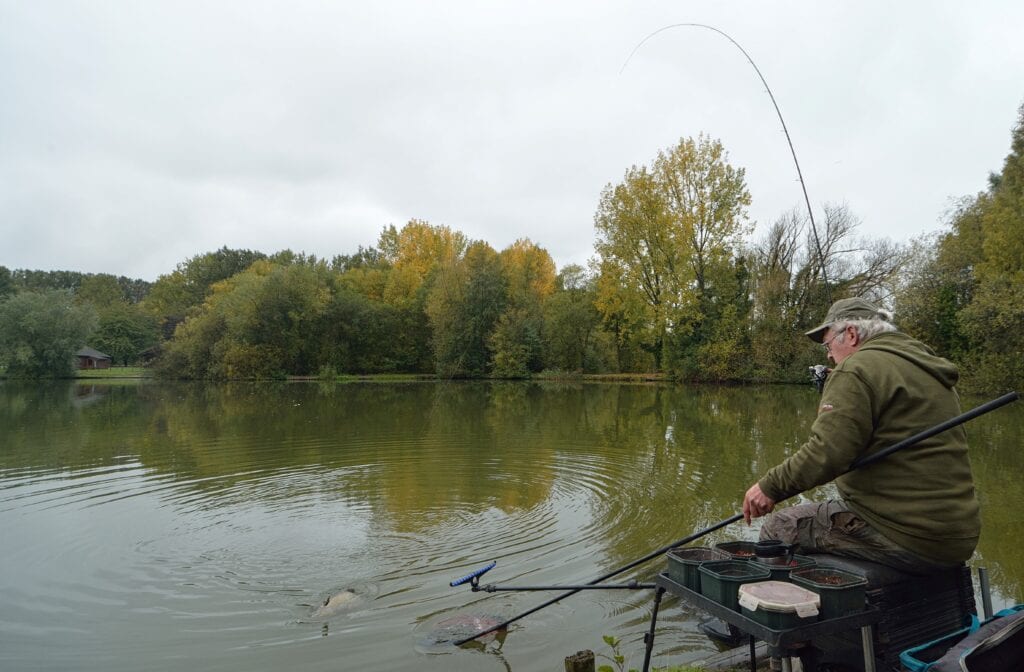
How long a rod do you need to explore further out than you might normally fish? One of the best feeder anglers I have ever seen was Nick Larkin (of Nisa Feeder fame) when I used to fish the River Yare. He mastered this river with an 11ft feeder rod, and used it for just about everything. Most anglers rely on 12-13ft rods for big chucks, but the clever bit is shorter rods help you to be more accurate. There is a new trend of using 10-11ft quivertip rods for distance when using method, hybrid or pellet feeders. You don’t need a long length of carbon to cast these models a long way, plus there’s no strike required because in-line feeder set-ups mainly self-hook. I’ve used a 10.5ft bomb rod with pellet feeders at 50 metres with no problems, something I wouldn’t do with standard feeders, where a more sweeping strike is needed. Softer-actioned rods are also helpful when using four-inch hook lengths, helping to avoid hook pulls. Distance fishing has certainly changed.
John Bailey – Distance Fishing
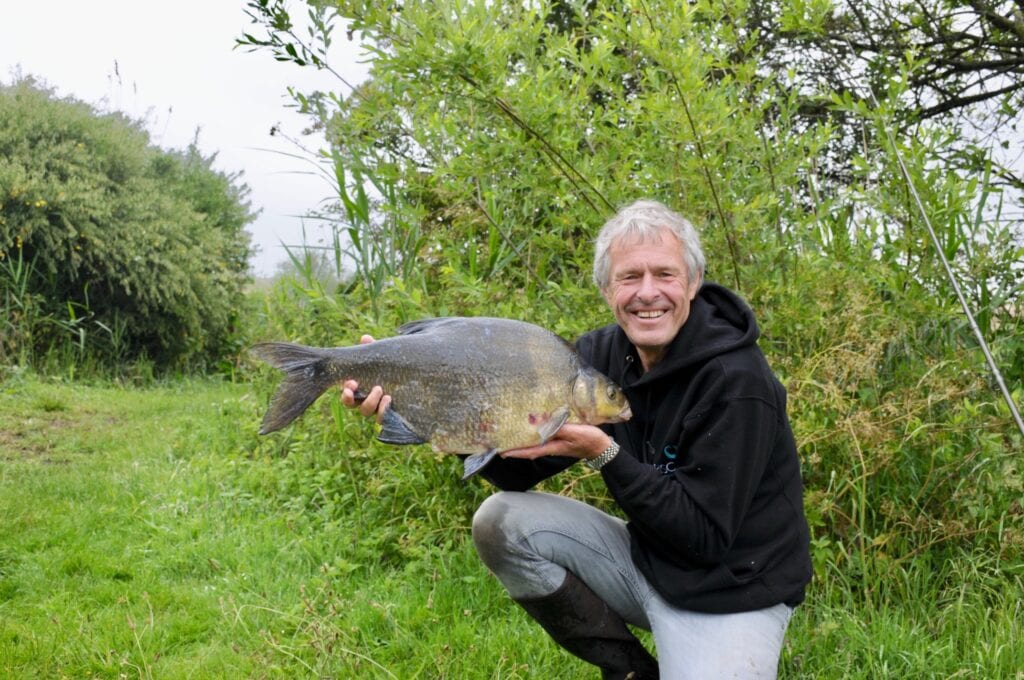
Over the last fifteen years of guiding I have just had to master fishing those extra yards, but it hasn’t come without struggle. To be frank, most of my stillwater fishing from the age of ten was done in Norfolk on estate lakes, generally five acres or sometimes considerably less. Then, of course, the reintroduction of otters from around 1998 changed all that. By the year 2010, I realised that if I were to continue fishing and guiding for tench and bream in particular, then I would have to relocate South to the big gravel pits up the Wensum and Yare corridors. Even then, at the start, I was always fixated by the margins and that first drop-off into deep water, where I still like to see my baits placed whenever I can. However, perhaps seven years ago, I realised that the float five yards out does not always produce the fish, especially bream. I increasingly understood that if I were to satisfy all my clients most of the time, then I’d have to cope with long-range work, like that or not. I was fortunate in running the Kingfisher Syndicate, a 25 acre, deeply-contoured lake, where the members were happy to help me out.
IT’S AN AGE THING
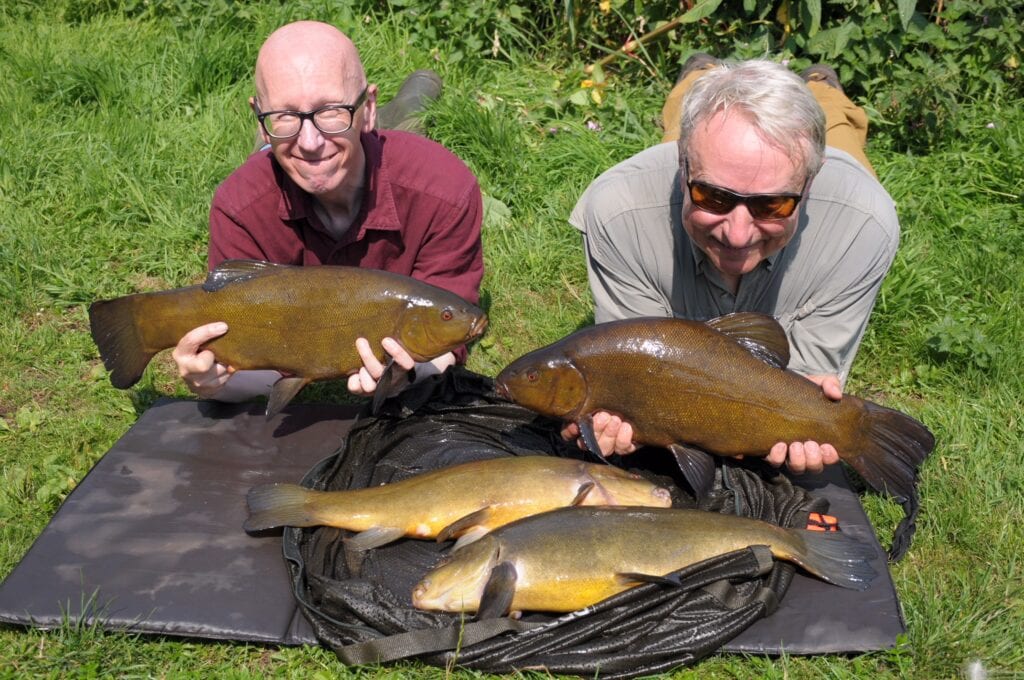
Messrs Halligan and Clark with 4 tench for 31.08 pounds, all taken at 80 yards
I guess they just took pity on me, if the truth were to be told. Distance is largely an age thing. If you are over fifty, then 50 yards is a stretch, whereas if you are under forty, 150 yards is a breeze. There are a few Old Rockers who cast all the way to the sun but even now, for me and my clients, I guess 70 to 80 yards is about as far as we feel comfortable with, but that very often catches the fish when close-in tactics have dried up. So, why and when should you think of going at least this moderate distance?
MARGINS SPELL DANGER
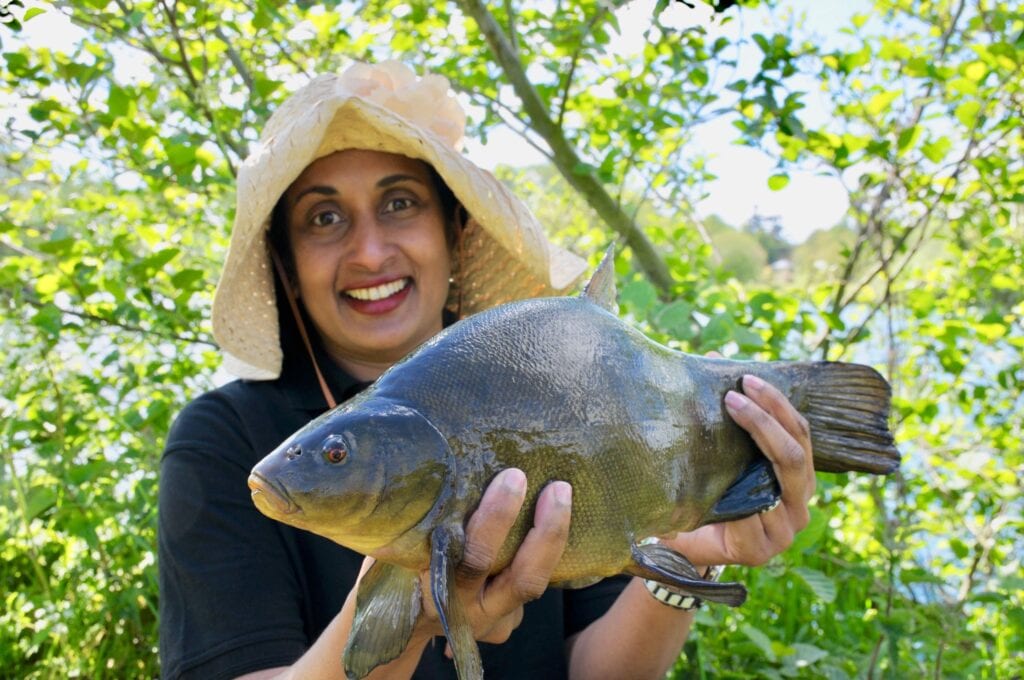
Enoka with a fine tench caught at 70 yards
In a perfect world, I’d fish that first drop-off we see in most gravel pits from spring through to the autumn, especially on a float, the way most Crabtree Converts like to do it. The trouble is that bream often don’t come in close at all, and tench begin after a while to associate the margins with danger and move further out. However, a lot of fish of both species only live at range, or at least most of the time. By casting that extra 70 yards or so, you are reaching not just new water, but very often new fish too. Pits have all those desirable features at range, as well as close in. Drop-offs, bars, gullies, plateaux, weedbeds, bloodworm beds, yes, there is just as much juicy territory out there as you’ll find at your feet. Also, from May, most carp spawn at range and are followed by egg-devouring tench and bream throughout the orgy period. Throw in the fact that open water attracts stronger, cooling winds in the hot weather, and you begin to see the advantages from the fishes’ point of view.
OBSERVATION PAYS

Carp do come amongst tench and bream as Simon Clark found!
Finding swims at 80 yards is obviously more difficult that spotting them at 8 yards. Observation is tops. I always watch the surface of any pit as I fish, especially in the early morning and late afternoon, but through the day too. Binoculars are essential tools and you are looking for rolling fish and, in calm conditions, bubbling fish. You soon begin to build up a map of where fish show, and potential hotspots that demand further investigation. Many of the pits are heavily carp fished. Get on well with the carpers and they will tell you where bream and tench predominate, probably because they avoid these areas if/when possible. My best bream swim during 2020 was gifted to me by a carp boy who moved on after being breamed out. My guys had an incredible eighty double-figure bream before the shoal eventually tired and moved off a month later.
EXPLORE THE DEPTHS
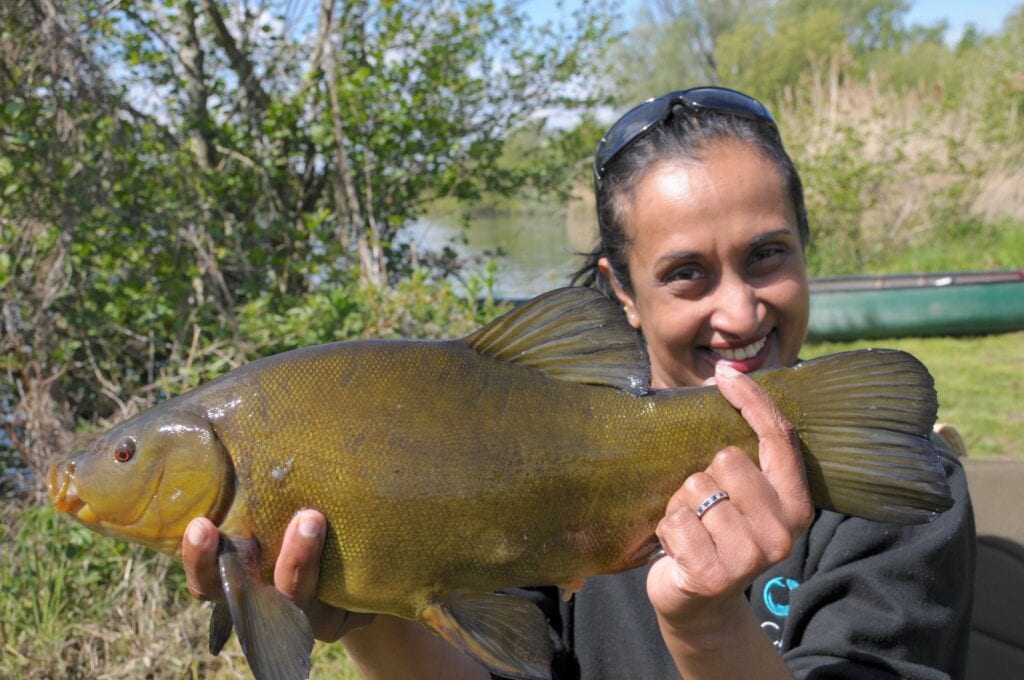
Enoka with a beauty
Once you have an idea about target areas, exploration with a rod, reel, line, and two ounce bomb is called for, braid by the way giving you more info than mono. Cast to where you have seen fish and count the lead down as it falls through the water column. You very soon begin to get the feel of deeps, shallows, and all the intermediate depths. As you pull back, study what the rod tip is telling you. If it bounces and jags, that lead is bouncing over clean gravel. If the lead slides back all smoothly, than chances are you are finding silt and possible bloodworm beds. If the lead simply buries stubbornly, then you are into thick weed. So, little by little, you begin to form a picture of what is going on out there. If I have ideal swims, they will be close to weed but not in it. They will be around 6-7 feet deep, but accessible to shallows and deeps both. I like to fish the sides of bars, features that often act as fish highways around the lake. Areas of 3-4 feet shallows can be hot in the early part of spring before heavy weed growth sets in.
NO BIG PIT POKERS
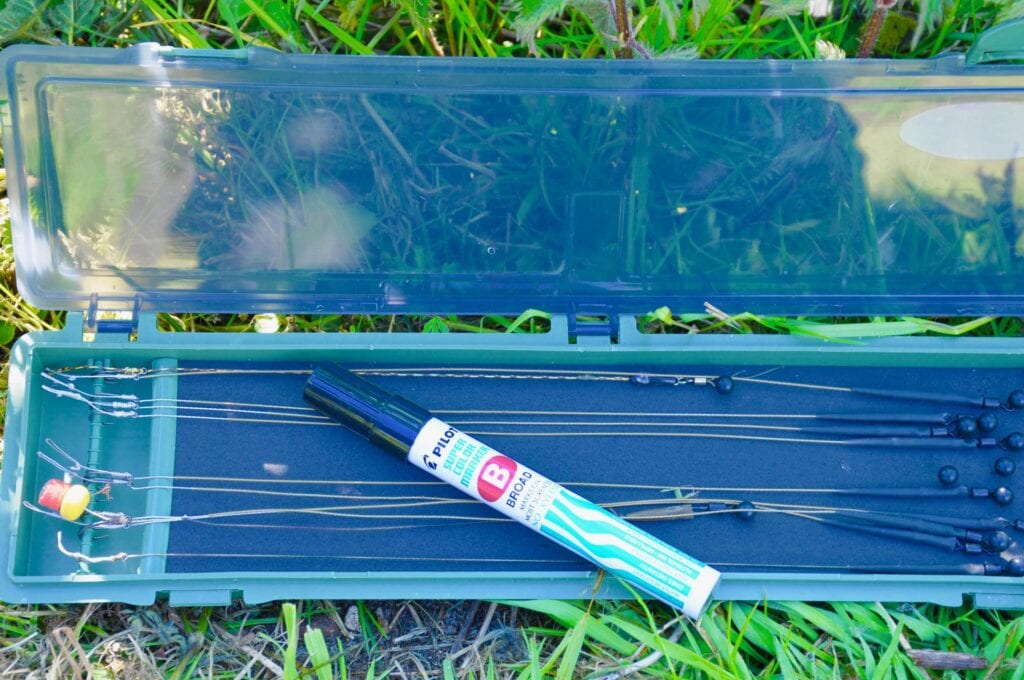
Notice the anti-tangle sleeves to avoid problems on the cast

A feeder-caught bream taken at 80 yards
Don’t obsess about gear, I tell my guys. Forget the need for 3.5lb TC carp pokers and big pit reels. 12ft Avons are fine, matched with 4500 size Shimanos which can take 100 yards of 10lb Maxima, plus a bit. I like to use a couple of yards of lead core above the feeders… or lead. This sounds a bit posh but it is easy to rig, helps nice line lay, and gives you massive security if you are having to bring big fish in over gravel bars, sometimes loaded with swan mussels. (Lead core also reduces the chances of getting under a carp’s scales should one wander your way.) I’d always prefer size 10 or even 8 hooks at distance, because there is a lot of pressure on anything smaller. Anti-tangle rubber sleeves help keep rigs straight after a long time in the air and reduce tangles. Even with them, watch the feeder in flight and feather it down at the end of the cast. Finally, using heavy bobbins signal drop-back bites well at range, and I use them as a matter of course these days.
CLIP FOR ACCURACY
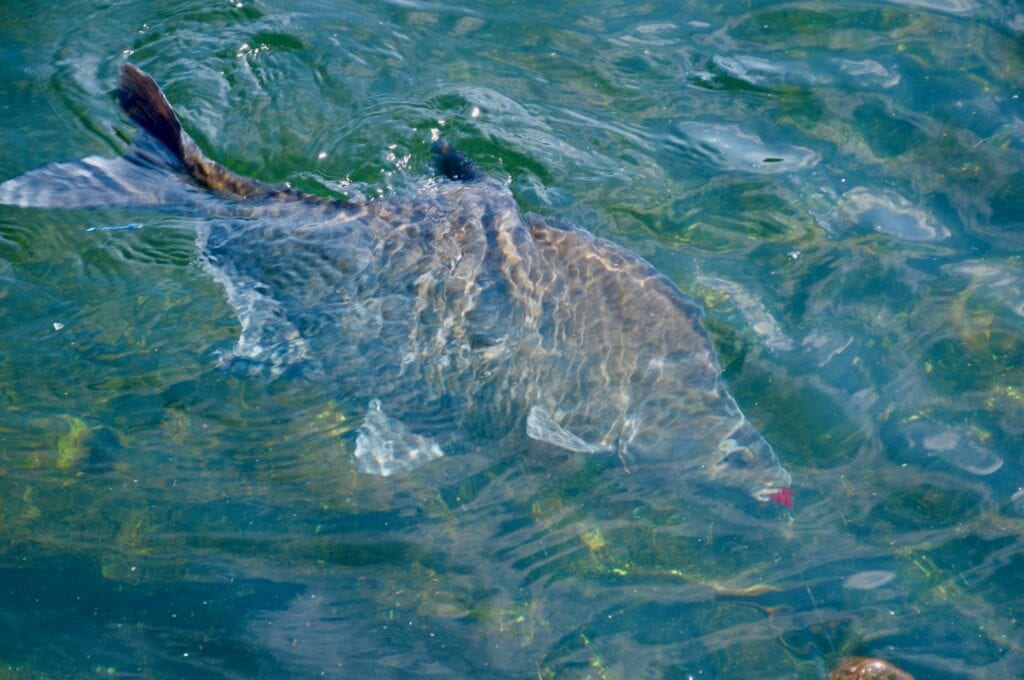

Bream, feeder and bait
Once you have your target area, you need to hit it with high percentage accuracy. Get your range and “clip up” by notching the line under the clip on the reel’s spool once the cast has been made. A piece of marker elastic tied just above the clip is a good idea too. When you can hear it flicking through the rod rings you know the distance is about to be reached and you can start that all-important feathering. (When actually fishing, I remove the line from the clip and replace it before reeling in. This saves many a rod disappearing like a javelin if a carp should hook itself.) Don’t stress about this. During a long session, you soon starting fishing instinctively and getting the distance spot-on by magic!
IT’S A WRAP
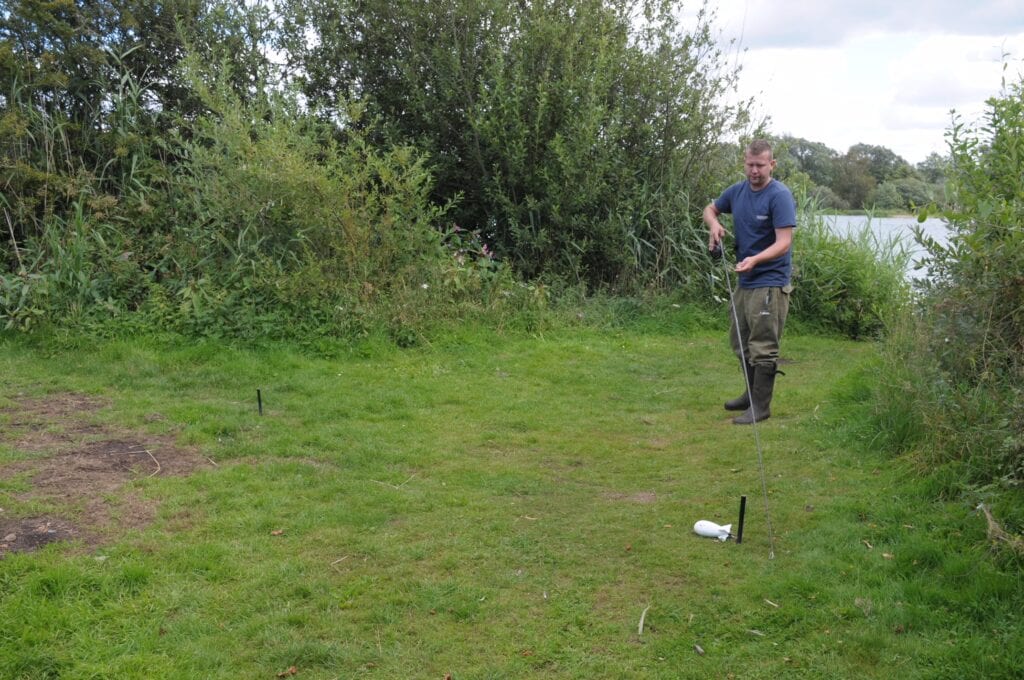

Toby shows how to operate the “wrap system”…

…and launch the Spomb too… notice he allows around
4-5 feet of drop beneath the rod tip
Accuracy, though, is important, as well as range. Look for markers on the facing bank that you can aim for as you cast. I habitually use trees, bushes, moored boats, reed beds, even pitched bivvies. If three rods are out, for example, I’ll pick three targets that are about five yards apart and that should keep tangles to a minimum. I ought to mention the wrap system briefly. You’ll see carpers with two bank sticks placed like goal posts in their pitch. If you weave your line line between these sticks from the feeder to the marker elastic and count the number of wraps, you’ll know exactly how far out you are fishing. For example, 10 wraps at 8 yards each equal 80 yards or thereabouts. This can be useful in the future if you keep a note of how many wraps are needed in each of your swims.
KEEP IT SIMPLE
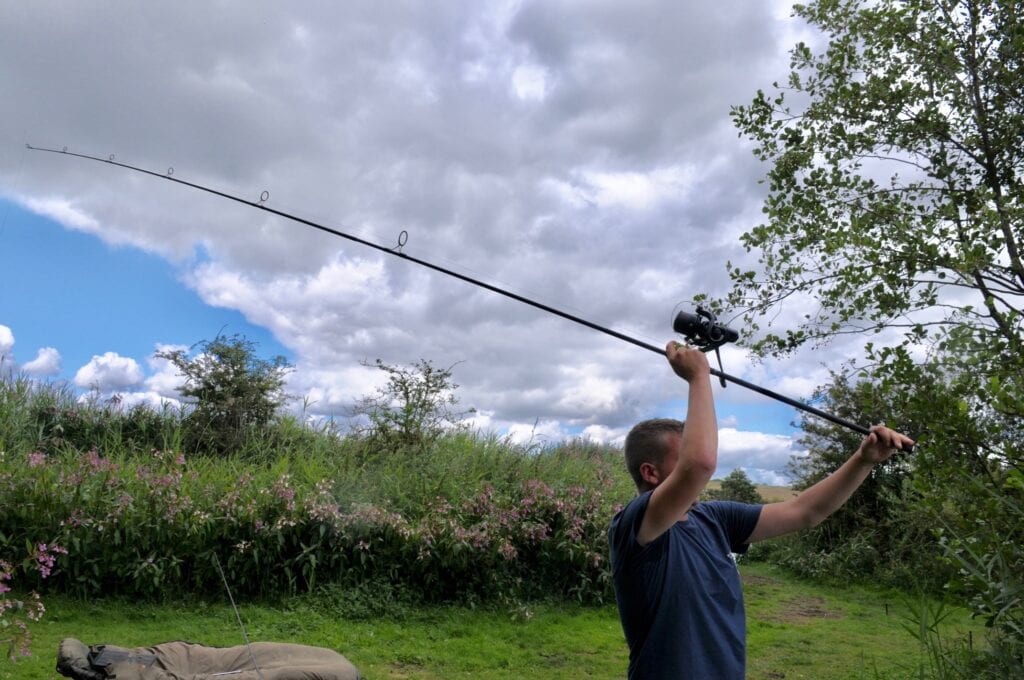
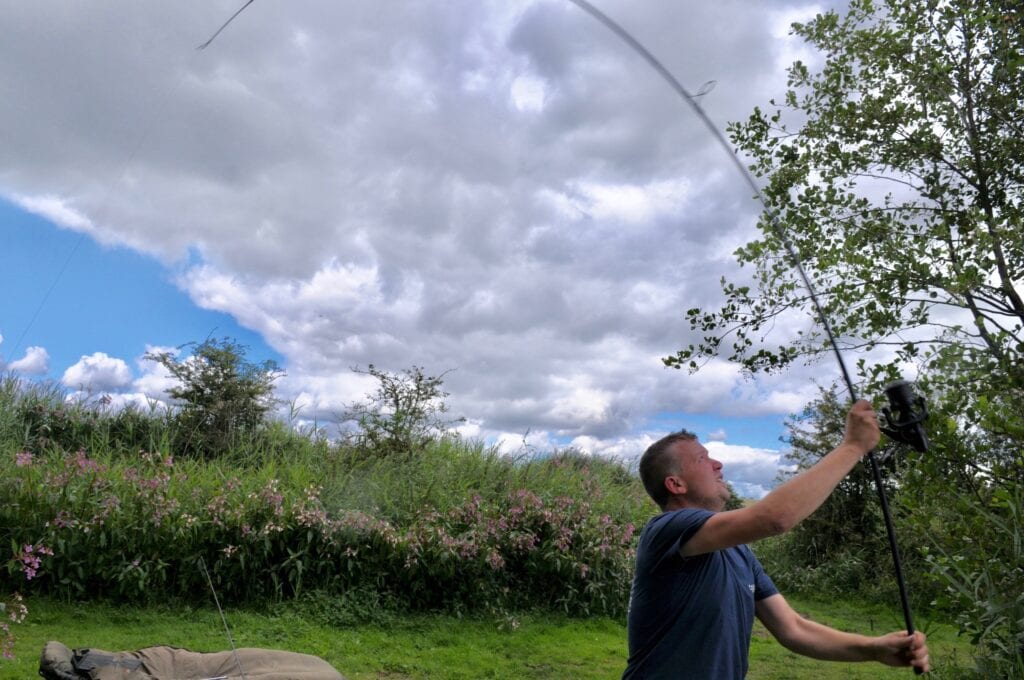
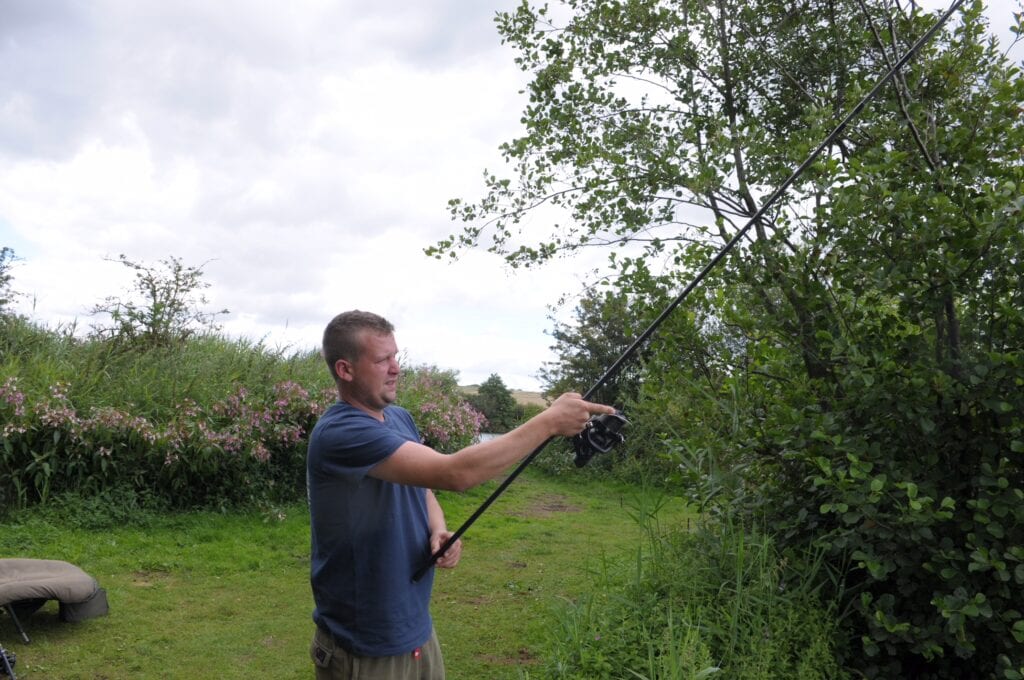
Champion carper Toby shows how the cast is done!
Don’t fret about your casting technique, and don’t care if the young carping bucks have a snigger while you are perfecting it. Relax, keep it simple and smooth. The trendy overhead cast looks a bit weird and posey, but think like it is throwing a javelin. Start with the feeder or lead about four feet beneath the rod tip and tighten the clutch a little so you don’t get spool slip as you build up momentum. Work on your timing. If you release your finger too soon, you’ll get height and no distance. Aim for a straight trajectory that achieves distance with ease and accuracy. Fish within your limits and don’t strain for distance… you’ll very soon build that up with a few practice casts.
SPOMBS ON BRAID

A good Spomb mix with additives
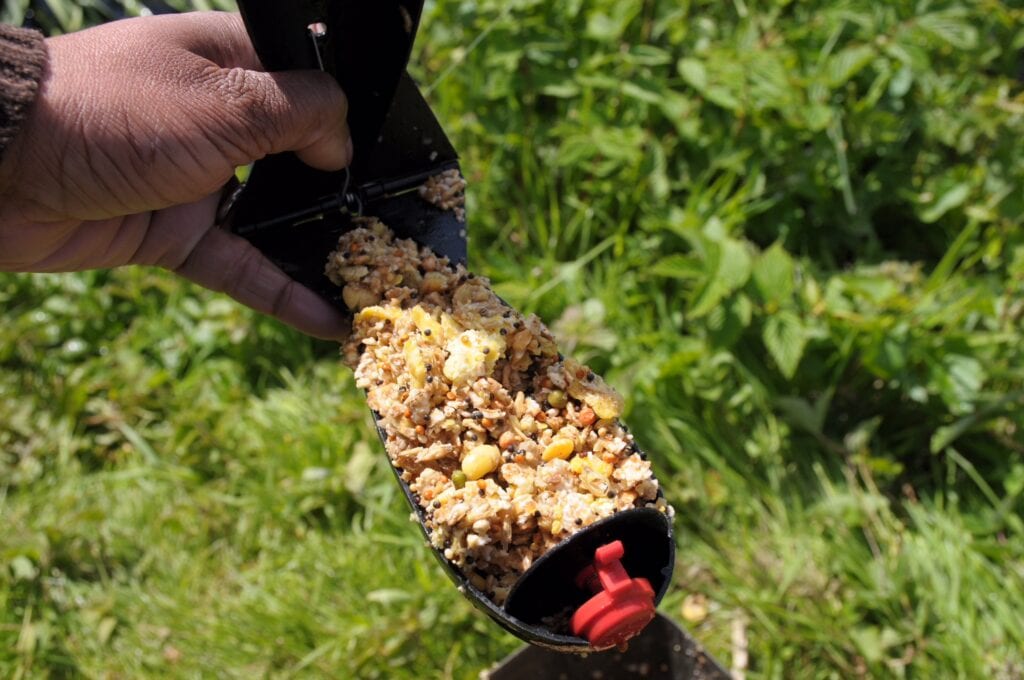
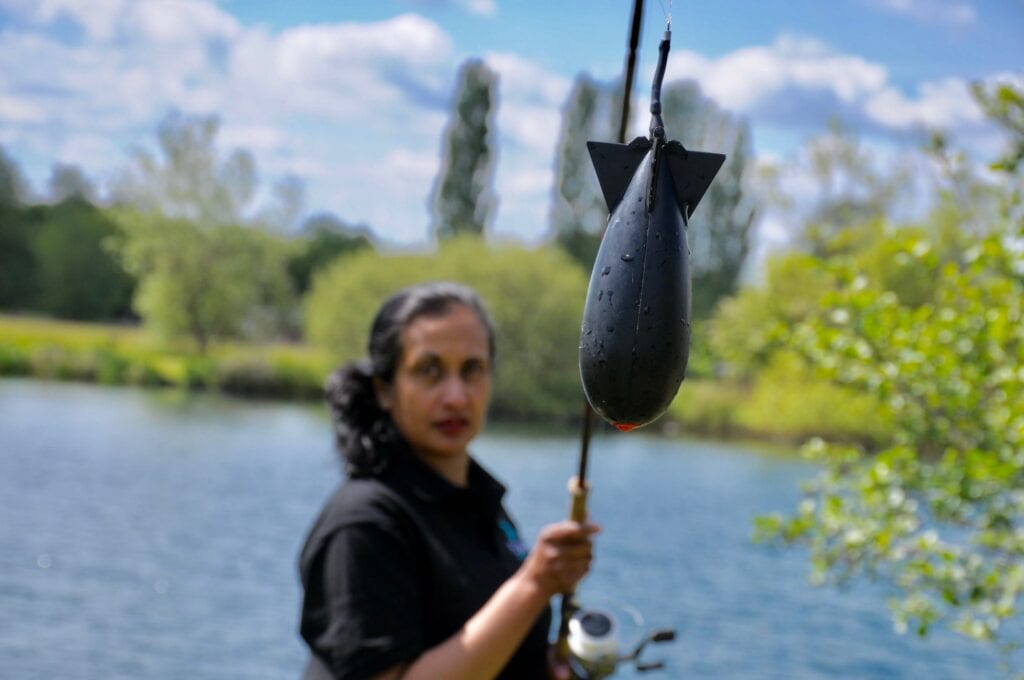
Filling the Spomb and Enoka about to launch it
Getting out the bait is always an issue, and I am a great one for Spombs attached to braid and flung out on a 3-4lb TC rod, using a 10000 reel or thereabouts. You soon begin to build up accuracy, especially if you clip up and remember the right number of wraps! Method feeders get a fair bit of bait out and boilies can be launched in a PVA bag… again, dead easy to use, I promise. And blockend feeders punch good numbers of maggots out too, especially if you have multiple rods on the go. Best of all, I like to go afloat with a couple of bucketfuls, and just get to the swim and bosh it over the side! You need someone bankside to direct as positions get blurred out there, and always wear a life jacket. I’ll save my thoughts on bait for a future piece, but Vitalin mixed with hemp, tigers, corn, mini pellets and crushed boilies has worked well for me as a base, especially if flavoured with molasses from a corn merchant.
BUILDING TO A BONANZA
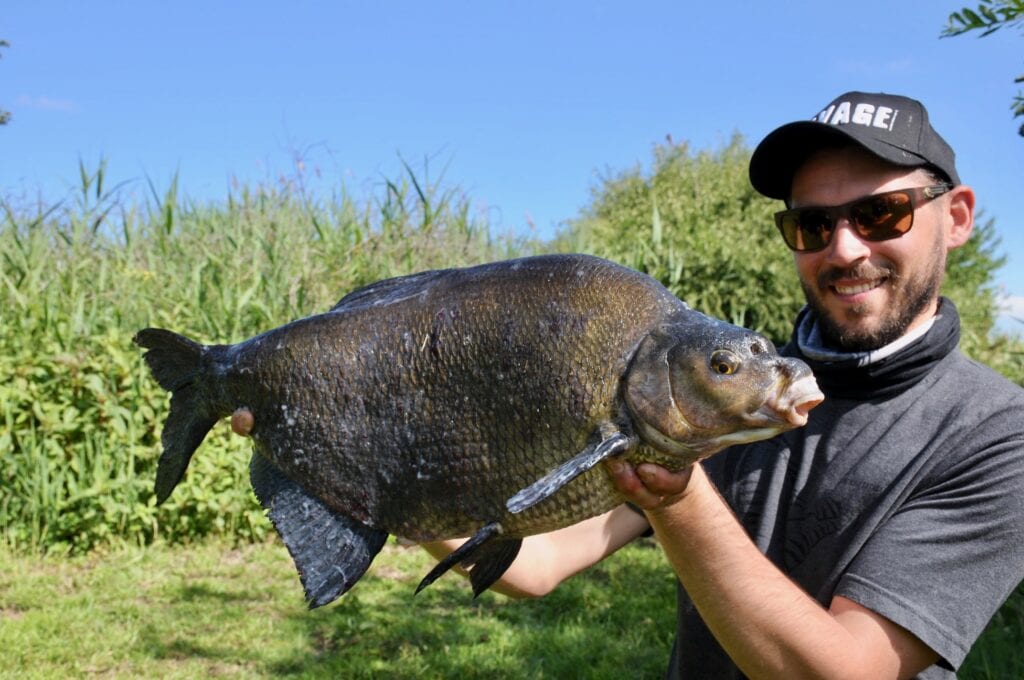
Robbie N with a long distance cracker
These sessions can build up to something spectacular. I love to fish three or four days consecutively and draw in more and more fish, but even in a few hours, the number of bites can escalate. At distance, play fish to the max! Keep the rods high. Get the fish up in the water and hustle them over weed and gravel bars. Do not let a fish bury deep into roots and snags, for its sake please. If fishing a number of rods, experiment with baits and change type and colour with frequency ’till you get the day’s preference. Remember, this style of fishing is not about rest. The harder you Spomb and feed, the better your catches. Get everything right, work hard and keep confidence high. Watch out for fish moving over your bait… a single rolling tench can signal a bonanza!
The post Bailey & Coster – Our Way with… Distance Fishing first appeared on FishingMagic Magazine.
Continue reading...
HITTING THE HORIZON
Match and pleasure anglers have discovered casting further can bring rich rewards, embracing long-range feeder tactics, and taking them to a new level. John Bailey says he too has had to follow the trend of casting into the beyond, due to predators and angling pressure. From a match fishing point of view, out-distancing those around you makes good sense, chasing after fish all the disturbance pushes away. Over in Ireland, yet another factor has forced anglers into longer casting, and that’s zebra mussels, which have filtered the colour out of many big Irish loughs. UK anglers who go to the Emerald Isle have learnt to add more metres to their fishing. Many have enjoyed this challenge, bringing the trend back to our shores. I managed to take this snap of my pal Chris, as his feeder rod followed through after being fully compressed for a huge chuck. Feeder fishing now embraces powerful quivertip rods and big pit-style reels, capable of casting massive distances.
KNOWING THE SCORE

If you are going to all the trouble of fishing an immense way out, it helps to know exactly where your end tackle is landing. Everyone uses a far-off feature to aim at, but the way we gauge feeder fishing distances is changing. Most anglers used to do this by counting the turns of line onto their reel, while winding back in from the target spot. But this is tedious, and easy to get wrong over big expanses. Far better to use measuring sticks (as JB has also mentioned), which give you the proper range in metres or yards, depending on how you space them. Many measuring sticks have a couple of marker toggles, allowing you to gauge two different feed lines. It’s popular practice these days to have a short-range feed area to kick off sessions, while waiting for the distant line to come to life. Using sticks is also far more accurate if you want to match up with your main rod’s casting distance by using a spodding rod, or having spare back-up tackle, such as different feeder set-ups.
FEEDER EVOLUTION

The type of long-range feeders anglers are using these days has in many cases changed. A few side lead groundbait designs can still be seen around, but these models have limited casting potential. Rocket-style cages with big base weights are not recent innovations, but I see these being used much more on big lakes, gravel pits and reservoirs. This style of groundbait feeder first originated in Holland, I believe. I remember seeing Dutch anglers using them on big, windswept Irish festival venues, way back in the early nineties. But the new boys on the block for long range are window feeders. These were first widely used in Ireland, thanks to the crystal-clear water problems previously mentioned, which have pushed the vast bream and roach shoals a long way out. Tough plastic cage feeders with weighty lead rings around their bases are also popular for long range, again originating from Dutch feeder anglers, who have always liked big chucks for their bream.
FEEDING REVOLUTION

The use of groundbait catapults has declined considerably. Much of this is undoubtedly to do with the extra metres anglers are adding to their casts, going well beyond the range catapults can comfortably manage. But there is more to this, because extreme-range feeder anglers are striving to be more precise, clipping up, and attempting to put their end tackle down the same hole every chuck. To begin with, this new precision way of fishing involved extra-big spodding-style cage feeders, to help build swims a lot faster. But proper spodding, similar to what carp and specimen anglers have been doing for years, has crept into the serious feeder angler’s armoury much more. This entails beefy, beachcaster-style rods and big pit fixed-spool reels with large-diameter alloy spools, loaded to the brim with thick braid. All this might sound a bit over the top, but the new type of Spombs deposit a lot more bait, just as accurately as a feeder and far more quickly.
TIMING IS KEY

If you are not careful, it’s easy to go to sleep while feeder fishing. Not literally, but becoming transfixed by watching what a quivertip is doing, or not doing. This can lead to forgetting about topping up with more feed, which is essential to build swims up. That’s why many long-range feeder anglers these days use timers. I’ve watched top feeder guys and they regularly make themselves wind in and cast more bait out for the first hour of a session, giving each cast a set amount of time. Once the bites start coming this can change, adding or subtracting a few minutes every chuck, depending on how the fish are responding. The clever bit with using a stopwatch, is you get to know exactly how long to give each cast before expecting a take. If one doesn’t come, your hook bait might be damaged, or could have come off, or maybe it has become buried in debris. Retrieving and casting again often brings an instant response. Active fishing catches a lot more fish!
CHANGING BAIT MENUS

Most long-range fishing, excluding carp, is aimed at bream and tench. It’s targeting these species that has forced JB’s hand into at least hitting the 70-80m zone. Big bream, in particular, can inhabit areas a long way from your bank quite naturally, but the way carp anglers fish and feed at range, almost by second nature these days, might be responsible for many big fish staying so far out. Also, due to the type of baits carp anglers use, it’s advisable to carry a good selection of grub when targeting feeder fish on big expanses of water. Green-coloured groundbaits with fishmeal are currently very popular. These are loaded with plenty of chopped worm, casters, and various sizes and types of pellets. Small expanders are something skimmers in particular like, switching to hair-rigged sweetcorn or banded wafters for bigger fish. It’s a case of working through a menu to see what works. Sometimes natural baits pay off, while on other occasions it’s pellets and wafters.
A NEW SCIENCE

I make no apologies for relying on my mate Chris to show how distance fishing is evolving, because he has put much more effort than I have into this new way of doing things. His sturdy fishing station is superbly geared up for stealing vital extra yards when set up well out in the water. Everything’s brilliantly tailored for housing plenty of bait, spare rods and whatever the weather can throw at it. My humble seat box, footplate and basic 40-year-old platform look a bit sad in comparison! But hey, if I concentrated on the big stillwater match circuit like my friend does, I would undoubtedly go the same way. For me this is more an occasional trip, as I have been preoccupied with a mixture of canals, drains, rivers, and mainly smaller venues since moving to the Midlands. Anyway, after priming the big-chuck part of his swim, then catching a few decent roach on a closer feed line, Chris has discovered bream and skimmers have arrived at distance. It only took them an hour.
THE HYBRID WAY

Another new type of feeder has revolutionised fishing at extreme range, casting more like a bomb or leger weight, and that’s the flat hybrid design. This is close to a method feeder minus the vanes, similar to a flattened leger weight, but with a shallow fence around it. The advantage match anglers like with hybrids is you don’t need to use a mould with them, so they are quick to load up with pellets or groundbait. Also, being super-streamlined, 40g and 60g versions cast incredible distances for their size. Favourite loadings are micro pellets or groundbait, the latter in fishmeal form during the warmer months, switching to sweet recipes in winter. This is basic stuff, using short links and buried hook baits, much like the method. Big bream respond to this tactic, which is particularly effective at range in shallow, weedy venues. Find where the fish are, and very often no extra grub is needed, just a few casts introducing some pellets or groundbait. Top hook baits are bunches of maggots, banded wafters, or hair-rigged corn. Altogether, a recipe for a great day’s sport.
FISH FINDING

Deeper sonar devices are helping anglers locate fish. This high-tech buoyant ball can be cast out on a spare rod (using strong line so as not to lose it!) and on the retrieve it shows up everything under water, on an iPhone or tablet. This gizmo highlights depth and bottom terrain, along with any fish, of course. The latter information helps when you are not catching, at least telling you something is out there. I have witnessed one of these fish finders being used by a mate on a rock-hard reservoir. We were both fishing a fair way out and couldn’t get a bite between us. He cast the ball into both our swims and, as you can see from the accompanying photograph, big fish were showing up everywhere, mainly hovering well off bottom. We tried everything but couldn’t make them feed. The interesting part was the tablet was showing fish where we were casting to, so at least our range finding was good. Personally, I like the mystery factor, so this is not really my cup of tea.
WHERE THEY LIVE

As JB has observed, sometimes the target fish, especially bream, don’t live where you like to fish. We all have our favourite methods and swims, but I for one will change what I’m doing if it makes a big difference. As JB says, there are just as many features at long range as there are closer in, so don’t ignore those far-off gullies, gravel bars, plateaux and distant islands. Simply blasting a feeder as far as you can into open water, and hoping the fish come to you, can work, but I know plenty of venues where swim knowledge is required. The bigger bream on some of the large lakes I fish just don’t budge very much, apart from the May/June period when they tend to shoal up and move off for spawning. Otherwise, there are only a handful of areas where they can be caught in large numbers. Having a powerful feeder rod comes in handy here, because the short-chuck swims are often taken. Being able to cast into the vicinity from the other side of the lake has its advantages!
THE AGE THING

As JB mentioned, there are some “old rockers” who can sling tackle as far as anyone, but age does have an effect on distance fishing, at least for most of us. I have watched carp anglers swishing out baits amazing distances, handling rods like Samurai warriors wielding their treasured swords. My mate Chris is super-fit due to his running, and whizzes out feeders so far, I can almost drink half a cup of coffee waiting for them to splash down. Some of us need to be careful here, because this distance stuff can cause sports-related injuries, like the time I got tennis elbow. Not funny because it took months to shrug off. But then again, a lot of good distance casting is down to perfect timing and compressing the blank properly. Some anglers stand up to launch out, while others who have mastered timing and physics, simply sit casually on their seat boxes and still hit the horizon. The catch Chris took here was not taken at extreme range, but at what I call dominant range.
LENGTH FACTOR

How long a rod do you need to explore further out than you might normally fish? One of the best feeder anglers I have ever seen was Nick Larkin (of Nisa Feeder fame) when I used to fish the River Yare. He mastered this river with an 11ft feeder rod, and used it for just about everything. Most anglers rely on 12-13ft rods for big chucks, but the clever bit is shorter rods help you to be more accurate. There is a new trend of using 10-11ft quivertip rods for distance when using method, hybrid or pellet feeders. You don’t need a long length of carbon to cast these models a long way, plus there’s no strike required because in-line feeder set-ups mainly self-hook. I’ve used a 10.5ft bomb rod with pellet feeders at 50 metres with no problems, something I wouldn’t do with standard feeders, where a more sweeping strike is needed. Softer-actioned rods are also helpful when using four-inch hook lengths, helping to avoid hook pulls. Distance fishing has certainly changed.
John Bailey – Distance Fishing

Over the last fifteen years of guiding I have just had to master fishing those extra yards, but it hasn’t come without struggle. To be frank, most of my stillwater fishing from the age of ten was done in Norfolk on estate lakes, generally five acres or sometimes considerably less. Then, of course, the reintroduction of otters from around 1998 changed all that. By the year 2010, I realised that if I were to continue fishing and guiding for tench and bream in particular, then I would have to relocate South to the big gravel pits up the Wensum and Yare corridors. Even then, at the start, I was always fixated by the margins and that first drop-off into deep water, where I still like to see my baits placed whenever I can. However, perhaps seven years ago, I realised that the float five yards out does not always produce the fish, especially bream. I increasingly understood that if I were to satisfy all my clients most of the time, then I’d have to cope with long-range work, like that or not. I was fortunate in running the Kingfisher Syndicate, a 25 acre, deeply-contoured lake, where the members were happy to help me out.
IT’S AN AGE THING

Messrs Halligan and Clark with 4 tench for 31.08 pounds, all taken at 80 yards
I guess they just took pity on me, if the truth were to be told. Distance is largely an age thing. If you are over fifty, then 50 yards is a stretch, whereas if you are under forty, 150 yards is a breeze. There are a few Old Rockers who cast all the way to the sun but even now, for me and my clients, I guess 70 to 80 yards is about as far as we feel comfortable with, but that very often catches the fish when close-in tactics have dried up. So, why and when should you think of going at least this moderate distance?
MARGINS SPELL DANGER

Enoka with a fine tench caught at 70 yards
In a perfect world, I’d fish that first drop-off we see in most gravel pits from spring through to the autumn, especially on a float, the way most Crabtree Converts like to do it. The trouble is that bream often don’t come in close at all, and tench begin after a while to associate the margins with danger and move further out. However, a lot of fish of both species only live at range, or at least most of the time. By casting that extra 70 yards or so, you are reaching not just new water, but very often new fish too. Pits have all those desirable features at range, as well as close in. Drop-offs, bars, gullies, plateaux, weedbeds, bloodworm beds, yes, there is just as much juicy territory out there as you’ll find at your feet. Also, from May, most carp spawn at range and are followed by egg-devouring tench and bream throughout the orgy period. Throw in the fact that open water attracts stronger, cooling winds in the hot weather, and you begin to see the advantages from the fishes’ point of view.
OBSERVATION PAYS

Carp do come amongst tench and bream as Simon Clark found!
Finding swims at 80 yards is obviously more difficult that spotting them at 8 yards. Observation is tops. I always watch the surface of any pit as I fish, especially in the early morning and late afternoon, but through the day too. Binoculars are essential tools and you are looking for rolling fish and, in calm conditions, bubbling fish. You soon begin to build up a map of where fish show, and potential hotspots that demand further investigation. Many of the pits are heavily carp fished. Get on well with the carpers and they will tell you where bream and tench predominate, probably because they avoid these areas if/when possible. My best bream swim during 2020 was gifted to me by a carp boy who moved on after being breamed out. My guys had an incredible eighty double-figure bream before the shoal eventually tired and moved off a month later.
EXPLORE THE DEPTHS

Enoka with a beauty
Once you have an idea about target areas, exploration with a rod, reel, line, and two ounce bomb is called for, braid by the way giving you more info than mono. Cast to where you have seen fish and count the lead down as it falls through the water column. You very soon begin to get the feel of deeps, shallows, and all the intermediate depths. As you pull back, study what the rod tip is telling you. If it bounces and jags, that lead is bouncing over clean gravel. If the lead slides back all smoothly, than chances are you are finding silt and possible bloodworm beds. If the lead simply buries stubbornly, then you are into thick weed. So, little by little, you begin to form a picture of what is going on out there. If I have ideal swims, they will be close to weed but not in it. They will be around 6-7 feet deep, but accessible to shallows and deeps both. I like to fish the sides of bars, features that often act as fish highways around the lake. Areas of 3-4 feet shallows can be hot in the early part of spring before heavy weed growth sets in.
NO BIG PIT POKERS

Notice the anti-tangle sleeves to avoid problems on the cast

A feeder-caught bream taken at 80 yards
Don’t obsess about gear, I tell my guys. Forget the need for 3.5lb TC carp pokers and big pit reels. 12ft Avons are fine, matched with 4500 size Shimanos which can take 100 yards of 10lb Maxima, plus a bit. I like to use a couple of yards of lead core above the feeders… or lead. This sounds a bit posh but it is easy to rig, helps nice line lay, and gives you massive security if you are having to bring big fish in over gravel bars, sometimes loaded with swan mussels. (Lead core also reduces the chances of getting under a carp’s scales should one wander your way.) I’d always prefer size 10 or even 8 hooks at distance, because there is a lot of pressure on anything smaller. Anti-tangle rubber sleeves help keep rigs straight after a long time in the air and reduce tangles. Even with them, watch the feeder in flight and feather it down at the end of the cast. Finally, using heavy bobbins signal drop-back bites well at range, and I use them as a matter of course these days.
CLIP FOR ACCURACY


Bream, feeder and bait
Once you have your target area, you need to hit it with high percentage accuracy. Get your range and “clip up” by notching the line under the clip on the reel’s spool once the cast has been made. A piece of marker elastic tied just above the clip is a good idea too. When you can hear it flicking through the rod rings you know the distance is about to be reached and you can start that all-important feathering. (When actually fishing, I remove the line from the clip and replace it before reeling in. This saves many a rod disappearing like a javelin if a carp should hook itself.) Don’t stress about this. During a long session, you soon starting fishing instinctively and getting the distance spot-on by magic!
IT’S A WRAP


Toby shows how to operate the “wrap system”…

…and launch the Spomb too… notice he allows around
4-5 feet of drop beneath the rod tip
Accuracy, though, is important, as well as range. Look for markers on the facing bank that you can aim for as you cast. I habitually use trees, bushes, moored boats, reed beds, even pitched bivvies. If three rods are out, for example, I’ll pick three targets that are about five yards apart and that should keep tangles to a minimum. I ought to mention the wrap system briefly. You’ll see carpers with two bank sticks placed like goal posts in their pitch. If you weave your line line between these sticks from the feeder to the marker elastic and count the number of wraps, you’ll know exactly how far out you are fishing. For example, 10 wraps at 8 yards each equal 80 yards or thereabouts. This can be useful in the future if you keep a note of how many wraps are needed in each of your swims.
KEEP IT SIMPLE



Champion carper Toby shows how the cast is done!
Don’t fret about your casting technique, and don’t care if the young carping bucks have a snigger while you are perfecting it. Relax, keep it simple and smooth. The trendy overhead cast looks a bit weird and posey, but think like it is throwing a javelin. Start with the feeder or lead about four feet beneath the rod tip and tighten the clutch a little so you don’t get spool slip as you build up momentum. Work on your timing. If you release your finger too soon, you’ll get height and no distance. Aim for a straight trajectory that achieves distance with ease and accuracy. Fish within your limits and don’t strain for distance… you’ll very soon build that up with a few practice casts.
SPOMBS ON BRAID

A good Spomb mix with additives


Filling the Spomb and Enoka about to launch it
Getting out the bait is always an issue, and I am a great one for Spombs attached to braid and flung out on a 3-4lb TC rod, using a 10000 reel or thereabouts. You soon begin to build up accuracy, especially if you clip up and remember the right number of wraps! Method feeders get a fair bit of bait out and boilies can be launched in a PVA bag… again, dead easy to use, I promise. And blockend feeders punch good numbers of maggots out too, especially if you have multiple rods on the go. Best of all, I like to go afloat with a couple of bucketfuls, and just get to the swim and bosh it over the side! You need someone bankside to direct as positions get blurred out there, and always wear a life jacket. I’ll save my thoughts on bait for a future piece, but Vitalin mixed with hemp, tigers, corn, mini pellets and crushed boilies has worked well for me as a base, especially if flavoured with molasses from a corn merchant.
BUILDING TO A BONANZA

Robbie N with a long distance cracker
These sessions can build up to something spectacular. I love to fish three or four days consecutively and draw in more and more fish, but even in a few hours, the number of bites can escalate. At distance, play fish to the max! Keep the rods high. Get the fish up in the water and hustle them over weed and gravel bars. Do not let a fish bury deep into roots and snags, for its sake please. If fishing a number of rods, experiment with baits and change type and colour with frequency ’till you get the day’s preference. Remember, this style of fishing is not about rest. The harder you Spomb and feed, the better your catches. Get everything right, work hard and keep confidence high. Watch out for fish moving over your bait… a single rolling tench can signal a bonanza!
The post Bailey & Coster – Our Way with… Distance Fishing first appeared on FishingMagic Magazine.
Continue reading...
